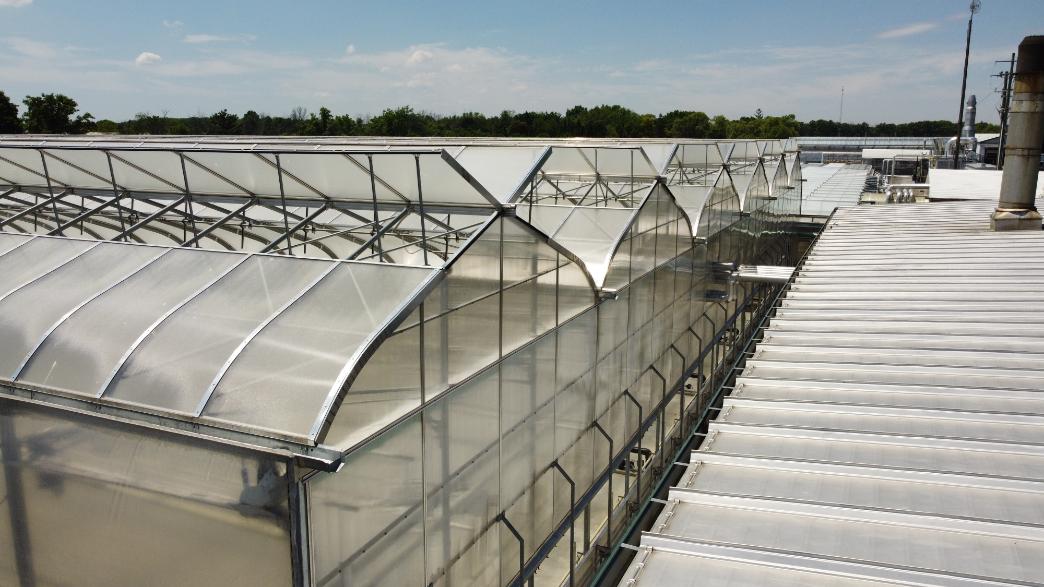7 Reasons Nursery Growers Should Be Growing In Gutter Connected Poly Greenhouses
 Many nursery growers grow and overwinter strictly in ground to ground hoop houses, but some progressive nursery growers over the last several years have been looking more and more to gutter connected poly greenhouses. Here are 7 reasons you may want to consider a gutter connected greenhouse for your next nursery expansion.
Many nursery growers grow and overwinter strictly in ground to ground hoop houses, but some progressive nursery growers over the last several years have been looking more and more to gutter connected poly greenhouses. Here are 7 reasons you may want to consider a gutter connected greenhouse for your next nursery expansion.
#1. It is easier to maintain desired temperatures in a gutter connect greenhouse compared to a ground to ground structure.
As growers we are always trying to keep the temperature in our greenhouses where we would like it. I found that growing in a properly equipped gutter connect gave me better control over the temperatures with less fluctuation. With roof vents and automated side walls it is amazing to see how fast you can reach the outdoor temperature, or your desired temperatures when cooling. On the other hand we all hate those dreaded cold nights when we have to start heating. Heating and keeping that desired temperature is much more feasible with a gutter connected poly greenhouse. The high gutters and high roof arches mean the volume of air in a gutter connected greenhouse is much greater. And the larger air volume keeps indoor temperatures from dropping quickly as outdoor temperatures cool down. This means that you will have better control over your heating. It is imperative that we have and are able to have better control over our cooling and heating needs in the greenhouse if you want to grow a consistent quality crop.

#2. Added flexibility for multiple crops in gutter connected poly greenhouses.
We all love to get multiple uses out of a single structure. With a gutter connected greenhouse you can grow one big crop under the whole range, or you can grow multiple crops with dividing walls all under the same roof. My experience with this was growing 3 different crops under one roof with dividing walls. We split the range into 3 sections and had gutter to floor dividing walls between the zones. We also had 3 separate zones on our environmental control computer. With this environmental control system we set heating and cooling all at different desired temperatures for the 3 separate zones. Then at certain times of the year we rolled up all the dividing walls up and grew as one large zone. I utilized the structure for 12 months of the year for multiple cycles of crops, so having rollup sides dividing walls was ideal. Some years we never needed the dividing walls but some years we would have 4 or 5 different crops under one roof. This added flexibility allowed us to be very responsive to customer demands and changes in the market place.
#3. Gutter connected greenhouses for better productivity and lower labour costs than hoop houses.
I always found that working in a gutter connected poly greenhouse was such a nicer and fresher environment. When people are happy they tend to work a lot better. In a gutter connect greenhouse you have everyone under one roof and not scattered over a bunch of coldframes or freestanding structures. This means less time wasted on going from house to house. It also means you can keep a closer eye on your employees if everyone is under one greenhouse. And in addition to productivity while managing a large crew in the winter you are not always opening and closing doors, letting all that expensive valuable heat escape.
#4. Much better for air movement.
In a gutter connected poly greenhouse you always have the option of roof vents and roll up sides. On a 14 foot to under gutter gutter connect you can put a side wall on that opens 10-11 feet high. This gives you a lot more air mass rushing through the gutter connect when cooling. Every GGS gutter connect also comes with the option of roof vents. They are usually raised gutter vents or gutter vents. The roof vents give you the option when the house is getting to warm to let that warm air escape. While opening the sides is good opening the roof is even better for the hot air to escape. It's a fact: hot air rises. So with a roof vent the hot air goes straight out the top. With a roof vent on a gutter connect and the house placed in the right direction the hot air is pulled out with the wind moving across the tops of the roof. It is like a suction for the hot air being pulled out of the roof vent. I found the best option in spring was to have the sides open and roof venting as well. It gave you the best of both worlds. The hot air would rise and go out the roof vent and the cool air from outside would flood through the sides. Most plants need and like good air flow; it helps prevent mildew and foliar diseases.
#5. User friendly gutter connected poly greenhouses.
Gutter connected greenhouses with tall straight sides and webbed trusses make it easy to install shade systems and overhead irrigation systems. The straight lines of a gutter connect allow for installation in a way that gives you complete coverage with ease. With opening sides ideally we would drop down the irrigation downspouts to just below the height of a fully opened side wall. This way your water isn’t splashing off sidewalls and making its way onto the plants. It is imperative we water our plants properly, and growing in gutter connected greenhouses makes it much easier. Also in a gutter connected greenhouse the trusses and all the overhead equipment can easily be installed high enough out of the way of your workers.
 #6. Gutter connected greenhouses maximize production land use.
#6. Gutter connected greenhouses maximize production land use.
When you build multiple ground to ground structures, whether Freestanding, or Coldframe you need to leave space between the hoop houses for snow removal, putting the poly on, operating rollup sides, etc. But in a gutter connected greenhouse range all the land space can be used for crop production.
#7. Gutter connected greenhouses make it easy for a grower to expand crop production.
Adding on to the side of a gutter connected greenhouse is very simple and cost effective. Most sidewall material can be moved to the new side once the expansion is completed. Expanding the electrical for computer controls, vent motors and lights is also much easier within a single gutter connected range than it is to bring power to a new freestanding greenhouse. Irrigation systems, heating systems, shading, and other automated controls for growing can generally be expanded easily as you add new bays to your gutter connect range.







